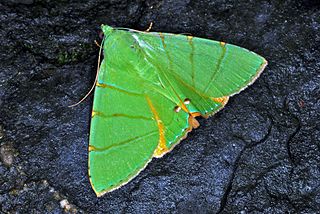
The Dalceridae are a small family of zygaenoid moths with some 80 known species encompassing about one dozen genera mostly found in the Neotropical region with a few reaching the far south of the Nearctic region.
Calocea is a monotypic moth genus of the family Noctuidae. Its only species, Calocea eucraspedica, is found in Mexico. Both the genus and species were first described by Harrison Gray Dyar Jr. in 1914.

Eulepidotis is a genus of moths of the family Erebidae erected by Jacob Hübner in 1823.

Collomena is a genus of moths of the family Nolidae described by Heinrich Benno Möschler in 1890. The Global Lepidoptera Names Index lists it as a synonym of Motya, but other databases such as Lepidoptera and Some Other Life Forms and Butterflies and Moths of the World list it as valid.

Acraga is a genus of moths of the family Dalceridae. The genus has neotropical distribution.
Ca is a genus of moths of the family Dalceridae.
Dalcerides is a genus of moths of the family Dalceridae. It was described by Berthold Neumoegen and Harrison Gray Dyar Jr. in 1893.
Paracraga is a genus of moths of the family Dalceridae.
Acraga angulifera is a moth in the family Dalceridae. It was described by William Schaus in 1905. It is found in Trinidad, Venezuela, Suriname and French Guiana. The habitat consists of tropical moist forests.
Acraga isothea is a moth in the family Dalceridae. It was described by Paul Dognin in 1914. It is found in Costa Rica and Panama. The habitat consists of tropical premontane wet and rain forests.
Acraga leberna is a moth in the family Dalceridae. It was described by Herbert Druce in 1890. It is found in Panama and in northern half of South America.
Acraga umbrifera is a moth in the family Dalceridae. It was described by William Schaus in 1905. It is found in French Guiana. The habitat consists of tropical moist forests.
Dalcerides sofia is a moth in the family Dalceridae. It was described by Harrison Gray Dyar Jr. in 1910. It is found in southern Mexico, Guatemala, El Salvador, Nicaragua and Costa Rica. The habitat consists of tropical moist, tropical dry, tropical premontane wet, subtropical moist, subtropical dry and warm temperate wet forests.
Acraga conda is a moth in the family Dalceridae. It was described by Harrison Gray Dyar Jr. in 1911. It is found in the Guianas.
Dalcerides dulciola is a moth in the family Dalceridae. It was described by Harrison Gray Dyar Jr. in 1914. It is found in southern Mexico, Costa Rica, Panama, northern Ecuador and northern Venezuela. The habitat consists of tropical wet, tropical moist, tropical premontane wet and tropical premontane rain forests.
Dalcerides nana is a moth in the family Dalceridae. It was described by Paul Dognin in 1920. It is found in southern Brazil. The habitat consists of subtropical wet and subtropical moist forests.

Dalcera abrasa is a moth in the family Dalceridae. It is found in Colombia, Venezuela, Guyana, Suriname, French Guiana, Brazil, Peru, and Bolivia.
Minacragides arnacis is a moth in the family Dalceridae. It was described by Harrison Gray Dyar Jr. in 1909. It is found in Colombia, Venezuela, Guyana, Suriname and Peru. The habitat consists of tropical moist, tropical premontane wet and tropical premontane moist forests.
Paracraga amianta is a moth in the family Dalceridae. It was described by Harrison Gray Dyar Jr. in 1909. It is found in Guyana. The habitat consists of tropical moist forests.
Paracraga halophora is a moth in the family Dalceridae. It was described by Harrison Gray Dyar Jr. in 1928. It is found in Brazil and southern Peru.



